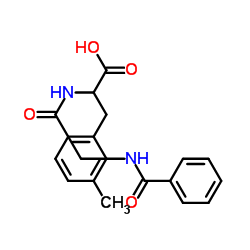sepharose cl-4b

sepharose cl-4b structure
|
Common Name | sepharose cl-4b | ||
|---|---|---|---|---|
| CAS Number | 61970-08-9 | Molecular Weight | 321.37636 | |
| Density | 1.040 | Boiling Point | 100℃ | |
| Molecular Formula | C19H20N2O4 | Melting Point | N/A | |
| MSDS | USA | Flash Point | 38 °C | |
| Symbol |

GHS02 |
Signal Word | Warning | |
|
Degradation of regulator of calcineurin 1 (RCAN1) is mediated by both chaperone-mediated autophagy and ubiquitin proteasome pathways.
FASEB J. 23 , 3383-92, (2009) Regulator of calcineurin 1 (RCAN1), a gene identified from the critical region of Down syndrome, has been implied in pathogenesis of Alzheimer's disease (AD). RCAN1 expression was shown to be increased in AD brains; however, the mechanism of RCAN1 gene regula... |
|
|
Immunoaffinity purification and gas chromatography-mass spectrometric quantification of 3-alkyladenines in urine: metabolism studies and basal excretion levels in man.
Carcinogenesis 14(2) , 199-204, (1993) Immunoaffinity gels were prepared by coupling monoclonal antibody (Mab) EM-6-47 to protein A-Sepharose, and were used to make small columns retaining 3-alkyladenines (3-alkAde) of diverse structure. An analytical procedure for determination of 3-methyladenine... |
|
|
Analysis of human ocular mucus: effects of neuraminidase and chitinase enzymes.
Cornea 17(2) , 200-7, (1998) Our goal was to establish the characteristic migration pattern on sodium dodecyl sulfate-polyacrylamide gel electrophoresis (SDS-PAGE) of high molecular weight mucins from human ocular mucus and the effects of treatment with exo- and endoglycosidases.Chromato... |
|
|
Immobilization of lipase from grey mullet.
Appl. Biochem. Biotechnol. 168(8) , 2105-22, (2012) Grey mullet (Mugil cephalus) lipase was isolated using para-aminobenzamidine agarose and immobilized on octyl Sepharose CL-4B (o-Sep). Immobilized grey mullet lipase (GMLi) had a 10 °C higher optimum temperature compared to the free enzyme and showed remarkab... |
|
|
Compared stability of Sepharose-based immunoadsorbents prepared by various activation methods.
J. Chromatogr. A. 584(1) , 17-22, (1992) During the use of chromatographic supports for the purification of proteins or the selective removal of substances by immunoaffinity, leakage of the antibodies immobilized on the matrix is systematically observed. When the cleansing of blood plasma by extraco... |
|
|
Sephadex-binding RNA ligands: rapid affinity purification of RNA from complex RNA mixtures.
Nucleic Acids Res. 29(2) , E4, (2001) Sephadex-binding RNA ligands (aptamers) were obtained through in vitro selection. They could be classified into two groups based on their consensus sequences and the aptamers from both groups showed strong binding to Sephadex G-100. One of the highest affinit... |
|
|
Hydrophobic interaction chromatography of homo-oligonucleotides on derivatized sepharose CL-6B. Using and relating two different models for describing the effect of salt and temperature on retention.
J. Chromatogr. A. 1006(1-2) , 137-48, (2003) The effect of salt and temperature on the interaction of homo-oligonucleotides with a derivatized Sepharose CL-6B hydrophobic support has been explained by the application of two different models: the solvophobic theory and the preferential interaction analys... |
|
|
Structural stability of fish myosin subfragment-1.
Comp. Biochem. Physiol.,. B. 95(2) , 255-9, (1990) 1. Tryptic cleavage of fish myosin subfragment-1 (S-1) revealed its similar substructure of heavy chain to that of rabbit S-1. 2. The structural stability of fish S-1 was studied by thermal denaturation method, and a rapid polymerization of inactivated fish S... |
|
|
Immunoadsorbents for clinical use: ex vivo immunoglobulin E removal in allergy.
J. Chromatogr. A. 563(1) , 166-71, (1991)
|
|
|
Antibodies released from immunoadsorbents: effect of support, activation and elution conditions.
Artif. Cells Blood Substit. Immobil. Biotechnol. 24(1) , 65-75, (1996) Immunoadsorption is an application of affinity chromatography, as a therapeutic method to specifically deplete biological fluids such as blood plasma from proteins in excess, or to extract a biomolecule from a complex mixture. However, the leakage of small am... |